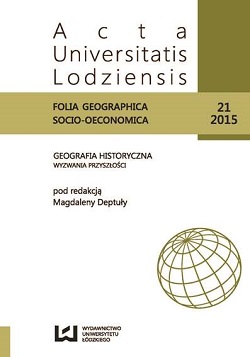Modelowanie obiektów topograficznych w bazach danych historycznych
DOI:
https://doi.org/10.18778/1508-1117.21.02Słowa kluczowe:
geografia historyczna, GIS, bazy danych, mapy archiwalne, modelowanie kartograficzneAbstrakt
Celem artykułu jest zaproponowanie koncepcji modelowania obiektów topograficznych w bazach danych historycznych w celu integracji geometrycznej i topologicznej. Głównym źródłem danych są mapy archiwalne w różnych skalach opracowane na przestrzeni 150 lat (od przełomu XVIII/XIX do połowy XX wieku). Ze względu na różnorodność materiałów źródłowych w celu integracji geometrii danych topograficznych zaproponowano podejście oparte na metodzie retrogresywnej.
Bibliografia
Dukaczewski D., 2005, Elektroniczna mapa animowana Gór Izerskich, „Polski Przegląd Kartograficzny”, 37(1), s. 23–36.
Google Scholar
Faluszczak F.P., 2011, Kartografia Galicji Wschodniej w latach 1772–1914, Wydawnictwo Uniwersytetu Rzeszowskiego, Rzeszów.
Google Scholar
Głażewski A., 2006, Modele rzeczywistości geograficznej a modele danych przestrzennych, „Polski Przegląd Kartograficzny”, 38(3), s. 217–225.
Google Scholar
Gochna M., 2014, Elektroniczna edycja rejestrów poborowych województwa kaliskiego z drugiej połowy XVI wieku, „Studia Geohistorica”, 2, s. 143–150.
Google Scholar
DOI: https://doi.org/10.12775/SG.2014.10
Gołębiowska I., Karsznia I., Mikiewicz D., Panecki T., 2012, Towards a historical GIS platform in Poland, [w:] Service-Oriented Mapping 2012, Jobst Media, Wiedeń, s. 417–430.
Google Scholar
Goodchild M.F., 1993, Data models and data quality: problems and prospects, [w:] Environmental modeling with GIS, Oxford University Press, Nowy Jork, s. 94–103.
Google Scholar
Gregory I.N., 2002, Time-variant GIS databases of changing historical administrative boundaries: a European comparison, „Transactions in GIS”, 6(2), s. 161–178.
Google Scholar
DOI: https://doi.org/10.1111/1467-9671.00103
Gregory I.N., Healey R.G., 2007, Historical GIS: structuring, mapping and analysing geographies of the past, „Progress in Human Geography”, 31(5), s. 638–653.
Google Scholar
DOI: https://doi.org/10.1177/0309132507081495
Konias A., 2010, Kartografia topograficzna państwa i zaboru pruskiego od II połowy XVIII wieku do połowy XX wieku, Wydawnictwo Naukowe Akademii Pomorskiej, Słupsk.
Google Scholar
Kreutzinger J., 1928, Topografja. Pomiar i zdjęcie kraju, kartografja i wojskowe znaczenie terenu, Wojskowy Instytut Geograficzny, Warszawa.
Google Scholar
Langran G., 1989, A review of temporal database research and its use in GIS applications, „International Journal of Geographical Information Systems”, 3(3), s. 215–232.
Google Scholar
DOI: https://doi.org/10.1080/02693798908941509
Langran G., 1992, Time in Geographic Information Systems, Taylor & Francis, London.
Google Scholar
DOI: https://doi.org/10.1080/10106049209354371
Leturq S., 2015, De l’usage de la méthode régressive en Histoire médiévale, http://www.menestrel.fr/spip.php?rubrique1565 (dostęp: 26.06.2015).
Google Scholar
Morillas-Torné M., 2012, Creation of a Geo-Spatial Database to analyse railways in Europe (1830–2010). A Historical GIS approach, „JGIS”, 4(2), s. 176–187.
Google Scholar
DOI: https://doi.org/10.4236/jgis.2012.42023
Nieścioruk K., 2013, Archiwalne materiały kartograficzne źródłem do rekonstrukcji przestrzeni dawnych wsi w strefie zabudowy miejskiej, „Studia Geohistorica”, 1(1), s. 39–47.
Google Scholar
DOI: https://doi.org/10.12775/SG.2013.04
Olszewski R., Gotlib D., 2013, Rola bazy danych obiektów topograficznych w tworzeniu infrastruktury informacji przestrzennej w Polsce, Główny Urząd Geodezji i Kartografii, Warszawa.
Google Scholar
Panecki T., 2014, Creating a common symbol classification for a new historical geoportal of Poland, „Miscellanea Geographica”, 18(4), s. 34–40.
Google Scholar
DOI: https://doi.org/10.2478/mgrsd-2014-0018
Reis Ferreira K., Camara G., Vieira Monteiro A.M., 2010, Towards a dynamic geospatial database model, http://mtc-m18.sid.inpe.br/col/sid.inpe.br/mtc-m18/2010/09.20.14.15/doc/2010_worcap_karineferreira.pdf?languagebutton=pt-BR (dostęp: 26.06.2015).
Google Scholar
Słoń M. (red.), 2014, Historical Atlas of Poland in the 2nd half of the 16th century, „Voivodeships of Cracow, Sandomierz, Lublin, Sieradz, Leczyca, Rawa, Plock and Mazovia ; Volume 2, Volume 3, Volume 4”, „Geschichte–Erinnerung–Politik”, 6, we współpracy z Agatą Staszewską i Martha Brozyna, Lang, Peter Frankfurt, Frankfurt am Main.
Google Scholar
Szady B., 2010, Granice powiatu łukowskiego w II połowie XVIII wieku – model liniowy i sieciowy, [w:] Narrata de fontibus hausta. Studia nad problematyką kościelną, polityczną i archiwistyczną ofiarowane Janowi Skarbkowi w siedemdziesiątą rocznicę urodzin, RW KUL, Lublin, s. 831–854.
Google Scholar
Szady B., 2013, Czasowo przestrzenne bazy danych jako narzędzie w geografii historycznej, „Acta Universitatis Lodziensis”, Folia Geographica Socio-Oeconomica, 14, s. 17–32.
Google Scholar
Urbański J., 2008, GIS w badaniach przyrodniczych, Uniwersytet Gdański, Gdańsk.
Google Scholar
Vrana R., 1990, Historical data as an explicit component of land information systems, [w:] Introductory readings in geographic information systems, Taylor & Francis, London–New York, s. 286–302.
Google Scholar
Wolski J., 2012, Błędy i niepewność w procesie tworzenia map numerycznych, [w:] Źródła kartograficzne w badaniach krajobrazu kulturowego, „Prace Komisji Krajobrazu Kulturowego”, Komisja Krajobrazu Kulturowego Polskiego Towarzystwa Geograficznego, 16, Sosnowiec, s. 15–32.
Google Scholar
Pobrania
Opublikowane
Jak cytować
Numer
Dział
Licencja

Utwór dostępny jest na licencji Creative Commons Uznanie autorstwa – Użycie niekomercyjne – Bez utworów zależnych 4.0 Międzynarodowe.








